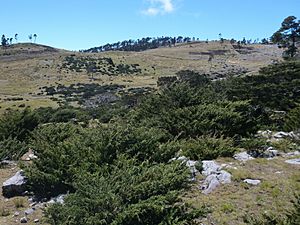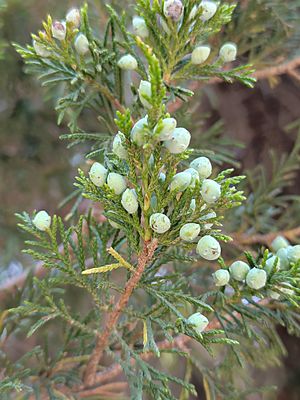Juniperus standleyi facts for kids
Quick facts for kids Juniperus standleyi |
|
|---|---|
 |
|
| Conservation status | |
| Scientific classification | |
| Genus: |
Juniperus
|
| Species: |
standleyi
|
Juniperus standleyi is a special kind of juniper tree. It grows naturally in Guatemala and a small part of southeastern Mexico, especially near a volcano called Volcán Tacaná in Chiapas. You can find these trees high up in the mountains, between 3,000 and 4,250 meters (about 9,800 to 13,900 feet) above sea level. Local people have different names for it, like huitó, cipres, and huitum.
Contents
About the Standley Juniper Tree
The Juniperus standleyi is an evergreen tree, which means its leaves stay green all year round. It's a type of conifer, like a pine tree. These trees can be a small shrub or grow into a medium-sized tree. They usually reach heights of 5 to 15 meters (about 16 to 49 feet), but sometimes they can grow as tall as 20 meters (about 65 feet).
Its Leaves
The leaves of the Standley juniper come in two main shapes:
- Young leaves: On young plants (called seedlings) or on older plants that are regrowing after being damaged, the leaves look like small needles. They are about 5 to 7 millimeters long.
- Adult leaves: On older, more mature plants, the leaves are tiny and flat, like scales. They are only about 1 to 1.5 millimeters long.
These leaves are arranged in a special way on the branches. They can be in pairs directly opposite each other, or they can be in groups of three that circle the stem.
Its Cones and Reproduction
The cones of the Juniperus standleyi look like small berries. They are round and measure about 6 to 9 millimeters across. When they are ripe, they are blue-black and have a thin, pale, waxy coating. Each cone usually holds three to six seeds inside. It takes about 18 months for these cones to fully mature.
The male cones are much smaller, about 1.5 to 2 millimeters long. They release their pollen in the spring. This juniper is a dioecious plant. This means that male cones and female cones grow on separate trees. One tree will only have male cones, and another tree will only have female cones.
Why This Juniper Needs Help
The Juniperus standleyi is an endangered species. This means it is at risk of disappearing forever. The main reasons it is in danger are:
- Habitat Loss: Its natural home, or habitat, is shrinking. This happens when forests are cut down for farming, building, or other human activities.
- Illegal Cutting: People sometimes cut down these trees illegally to use them as fuelwood (wood for burning).
Protecting these unique trees is very important to keep our planet's plant life healthy and diverse.
See also
 In Spanish: Huitó para niños
In Spanish: Huitó para niños



